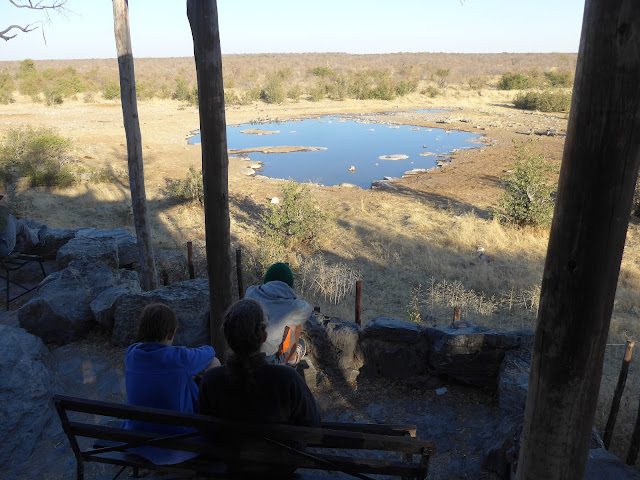The boys are out of school, and time to take one last journey in Africa. We started in Zambia, one night at the MCC guesthouse in Lusaka, then bus to Victoria Falls.
 |
| Two days to explore the Victoria Falls gave us time to enjoy lots of views, plus track down many new birds. |
 |
| From the Zim side. The water was still high, so plenty of opportunity to get soaked from the mist. |
 |
| Camping for 11 days in Namibia, we enjoyed the clear dark southern skies every night. The southern cross was our companion, lower middle left in this timelapse picture. The trees around our campsite are red from the light of the camp fire. |
 |
| A 19 kilometer hike in the Naukluft mountains gave us great views of the Namibian mountain landscape. It all reminded us of our days hiking in Arizona! |
 |
| The rugged landscape is covered by an assortment of unique trees, most of which we could not identify. Fig trees such as this one we do know - common throughout Africa and often perched in the most unlikely places. |
 |
| Of course we enjoyed the birdlife. Much of it was fearless, like this pale-winged starling that seems interested in our morning coffee. |
 |
| Miles and miles of desert landscape in the clear desert sky. |
 |
| Camping at Sesriem, on the edge of the huge dune fields of the Namib desert, we took an evening hike up a nearby dune. Our clothes had some sand in them by the end... |
 |
| The late afternoon light in winter was amazing on the dunes. |
 |
| In the morning near deadvlei, deeper in the dune field. We head to the top of "big daddy", the tallest dune (about 1000ft hike up). |
 |
| Nearing the top of big daddy. |
 |
| At the bottom of big daddy is deadvlei, a salt flat with dead trees that are some 500 years old. |
 |
| Down near Swakopmund we take a tour in the coastal dune fields looking for desert plants and animals. Here our guide digs for geckos, snakes, or something. Despite the appearance, the dunes had lots of life in them. |
 |
| One common inhabitant of the dunes, a gecko that was dug up from a slip face. |
 |
| Another resident, a small viper that waits in ambush in the sand. Only the eyes and head scales are visible here, well camouflaged. |
 |
| With some prodding the snake came out of the sand. Like other snakes, it moves by side-winding, like a sidewinder rattlesnake in North America. |
 |
| At Spitzkoppe, we had a campsite tucked between massive granite rock formations. Alex starts the fire for the evening braai (grilled food), a la southern Africa. |
 |
| Surveying Spitzkoppe mountain in the morning light. |
 |
| Mom and son getting breakfast out in the morning. We had our rooftop tents that easily fold up for the day's journey. |
 |
| At Cape Cross we visited the well-known seal colony, estimates of which are around 100,000 seals. Indeed, seals were visible, heard and smelled for a long distance around the site! |
 |
| Seals and more seals... |
 |
| Entering the Skeleton Coast national park, heading north to more and more desolate and isolated country. |
 |
| The area is known as the skeleton coats because of all the shipwrecks. Here the remains of a fishing vessel from the 70's are still visible. |
 |
| Driving inland from the skeleton coast we start to see welwetchia, well known oddities in the botanical world that only live in the Namib desert area. They're actually conifers, living thousands of years out on the gravel fields of the desert. |
 |
| Several days at Etosha National Park fulfilled our need for seeing animals. The wildlife was slightly different than what we see in East Africa, such as the greater kudu here. |
 |
| Water holes are the specialty of Etosha, as the dry season is progressing, lots of animals were visible at the many water holes. |
 |
| Hornbills are some of our favorite bird sightings wherever we go in Africa. |
 |
| We watched some young male lions at one water hole, who looked hungry but weren't interested in putting too much effort into actually getting the food (ahem, teenage boys...) |
 |
| Water hole at one of our campsites. Spotlights are on in the evening, which made a nice evening show for all the campers. At this hole we were entertained by rhinos and hyenas sparring for position. |
 |
| Black-faced Impala, a regional subspecies. |
 |
| The good German food was also a highlight for our Namibia time. Here I enjoy a "game wiener schnitzel" (some undefined wild game, maybe springbok, eland, kudu?). Evan goes healthy with a salad, good for him. The day after his birthday, he proudly wears his new Man U football jersey! |
 |
| At Waterberg, we have a bittersweet last night of camping in Africa under a camelthorn tree. One of many things we will sorely miss in only a few weeks! |
 |
| Morning hike to the top of the Waterberg plateau. Then we headed back to Windhoek to return our vehicle and catch a flight the next morning back to Nairobi. |

































What a fascinating journey! Makes me wish to be younger and have the opportunity to be in such wildness ---such open spaces with surprising wildlife..... Thank you for this food for the imagination!
ReplyDeleteDoug
ReplyDeleteYour old prof here--what an adventure and it is so fulfilling to see you and your family. Best wishes to you and keep up the good work. So proud of what you have achieved. Max